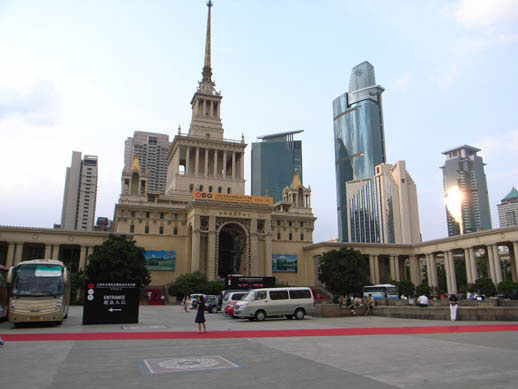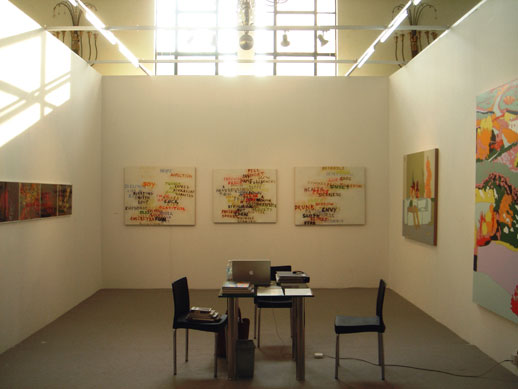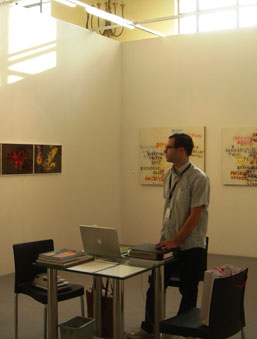Taka Ishii Gallery in Shanghai

How are the sales going?
It’s a good fair but sales are non-existent for us, although it’s not finished yet. I really think that it is an important event, even if you don’t sell much. I hope to sell enough to cover the expenses of participating in the fair!. Usually, at an art fair, a great deal of the sales take place on the first day; here there have been many people taking down the prices of works that we’re showing, so I’m hopeful. But having not sold anything yet leaves me a bit depressed…
Overall it feels like we’re establishing contacts. People from young Chinese institutions come by and chat, writers come by and chat, so I feel like it is a nice investment for the future of art in Asia. These things take time. You’d expect, for example, a fair like Frieze in London to be commercially successful commercially because there is a real structure of support that will facilitate commercial success.
How did the organization of the fair go for you?
I think that energy here is very good, people are really nice and the fair is supper well organized. I’m surprised, because leading up to the fair, it seemed like everything would be a wreck, everything was so behind schedule; deadlines did not matter. I expected that everything would be a mess, that I’d come here and the walls would be crooked or the booths would be designed incorrectly, which happens at fairs all the time. But everything was very well organized and if I had any problems, they were all solved very quickly.

Where do the visitors, dealers, collectors who come to your booth come from?
It seems that the people who are interested in our works are coming primarily from Korea and a little bit from Indonesia, but not from China. Without being too cynical, when we chose artists to display at this fair, we had in mind that it would be collectors from outside of Japan that have an interest in the work. Although we have not sold anything yet, it seems like this was the right decision. Dealers and collectors from Europe were interested in the Sean Landers’ works on the back wall, but no one from Asia was interested in Sean’s works.
Why did you decide to join the fair?
It’s difficult to say for certain, but I would think that not having a some sort of dialogue would be irresponsible and just plain silly. Within the art world, certain tensions could be set aside and we can work together to build something. Most galleries have no idea what’s happening in the Chinese contemporary art world, so this is one step towards changing that.
On a personal level, it’s hard for me to be a filter, because I have an idea of what contemporary Chinese art looks like and I see a lot of it but I either don’t understand or it just does not suit my taste. This fair is just one step toward gaining some understanding about what we’re looking at. Also, the artistic director, Pierre Hubert, who seems to be friends with everybody in Tokyo is the main reason why we’re here; he was pushing us to participate.
How do you find this fair compared with Art Fair Tokyo?
The intensity is very different. I think Art Fair Tokyo seems to have a little bit of an agenda towards trying to make it international, but it is still a very regional fair. For example, Art@Agnes is a young fair with energy because it is about promoting the younger galleries in Tokyo. So, even if it is regional, that’s okay because there is something original and interesting going on there.
It’s very personal feeling: I live in Japan, but maybe for a gallery from Spain coming to Art Fair Tokyo would get a positive feeling out of it, as though they are in the middle of something new and exciting. But as a gallerist in Tokyo, I don’t have that feeling at Art Fair Tokyo yet!
There is a little bit of a market in Tokyo now, so I feel safer encouraging people to come. Before it was hard: you’d have to encourage people to come to Japan, tell them that it is a nice place to make contacts but they’d not sell anything. But now it’s changed a little bit.

Which galleries here in Shanghai have attracted your attention?
The Chinese gallery across the hall seems to have a lot of energy, but the other Chinese galleries have not caught my attention at all. I’ve looked as much as I can, and it was generally what I expected: anything that has caught my attention has not been from an Asian gallery but rather a gallery like Max Protetch from New York. Their booth is so well installed and it contexualizes the Chinese works in a way that I have not seen before.
I was in Houston two months ago, where there was a museum show of contemporary collections of Asian art, primarily Chinese but also Japanese and from elsewhere. There was a panel discussion at which Max Protetch talked about Chinese art and showing slides. I was wondering what it is he sees that I don’t see, because his aesthetic is so clearly defined. I still don’t know what it is he sees that I don’t, but if you contextualize a certain style of painting, all of a sudden it begins to speak in a language that I can kind of understand. His booth got me thinking
How do you find the division of this fair into the categories ‘best of artists’, ‘best of discoveries,’ ‘best of galleries’?
I have a problem with the silly names and I think there was not enough care and enthusiasm in choosing the categories and in the selection of artists and galleries within them: a little bit more care paid to this would have made a lot of difference. As this fair continues, and I hope it will, there will be a few more international galleries here and the show will have a clearer focus to it.
There is a bit too much pretense to try and make this art fair come across as something new and unusual. We don’t need that, because it really is just an art fair, like every other art fair. The only difference is that it is in Shanghai and it is about supporting and creating an Asian art market.
Aneta Glinkowska
Aneta Glinkowska



